12 Essential Grants for Church Repairs in 2025
Discover the top grants for church repairs to preserve your sacred space. Our list covers eligibility, deadlines, and application tips for major funding.

Maintaining a historic or community-centered church is a profound responsibility, but aging roofs, crumbling foundations, and outdated systems present overwhelming financial challenges. Securing funding is often the biggest hurdle between critical repairs and a thriving future for your congregation. This guide demystifies the process by providing a curated and comprehensive list of 12 essential grants for church repairs. We've compiled the most impactful federal, national, and specialized funding sources to help you navigate this complex landscape.
Each entry in this resource list details crucial information:
- Who is eligible and what projects are prioritized.
- Typical funding amounts you can realistically expect.
- Application deadlines and key timelines to watch.
We move beyond a simple list, offering practical tips to position your application for success. Whether you're facing emergency repairs after a natural disaster, planning a major historic restoration, or upgrading community facilities, this article is your starting point. You'll find direct links and screenshots for each resource, designed to help you quickly identify the financial lifeline your sacred space needs to continue its mission. Let's explore the funding opportunities available to preserve your cherished building for generations to come.
1. Fundsprout
Fundsprout is an AI-powered grant success platform that offers a comprehensive solution for nonprofits seeking funding for critical projects, including grants for church repairs. Instead of merely listing opportunities, Fundsprout acts as a strategic partner, leveraging artificial intelligence to manage the entire grant lifecycle from discovery to compliance. It scans over 275,000 funding sources daily to deliver a customized pipeline of federal, state, and foundation grants tailored to your church's specific needs, location, and organizational capacity.

The platform’s intelligent features streamline what is often a complex and time-consuming process. Its competitive intelligence tools identify grants where your organization has a distinct advantage, ensuring your team focuses its efforts on the most winnable opportunities. This is particularly valuable for church committees that may lack a dedicated grant writer. Fundsprout’s AI writing assistant can transform your existing documents and impact data into compelling proposal narratives, significantly reducing the time spent on drafting applications.
Key Features and Strengths
Fundsprout distinguishes itself with a suite of tools designed to maximize efficiency and success rates. For churches needing to fund a roof replacement, historical preservation, or accessibility upgrades, these features are transformative.
- AI-Powered Grant Matching: The platform's algorithm goes beyond simple keyword searches, analyzing your programs and needs to deliver highly relevant grant opportunities.
- RFP Analyzer and AI Writer: This tool deconstructs complex grant applications into clear, manageable outlines. The AI assistant then helps draft narrative sections in your church’s authentic voice, complete with citations.
- Comprehensive Project Management: An integrated system visualizes tasks, tracks deadlines, and manages compliance requirements, preventing missed milestones.
- Automated Reporting: The platform simplifies funder reporting by auto-populating templates and maintaining a full audit trail, which is essential for managing grant renewals and maintaining good standing.
Practical Application for Church Repair Grants
Churches can use Fundsprout to build a sustainable funding strategy. By setting up a project profile for a specific repair, such as "historic steeple restoration," the platform will continuously scan for relevant preservation grants. The AI writer can then use documents like historical records, architectural assessments, and community support letters to craft a powerful narrative. The planning tools ensure that all application components are submitted on time, a critical factor for securing competitive grants. You can explore a curated list of opportunities in the free grant database from Fundsprout.
Availability: Fundsprout is a subscription-based platform, offering a 14-day free trial to allow organizations to explore its features before committing.
2. Grants.gov
Grants.gov is the official, centralized online portal for finding and applying to over 1,000 federal grant programs from 26 different agencies. While it doesn't directly provide grants for church repairs, it is the essential starting point for any organization seeking federal funding. This platform lists opportunities for historic preservation, disaster recovery, and community facility improvements that churches can often qualify for.
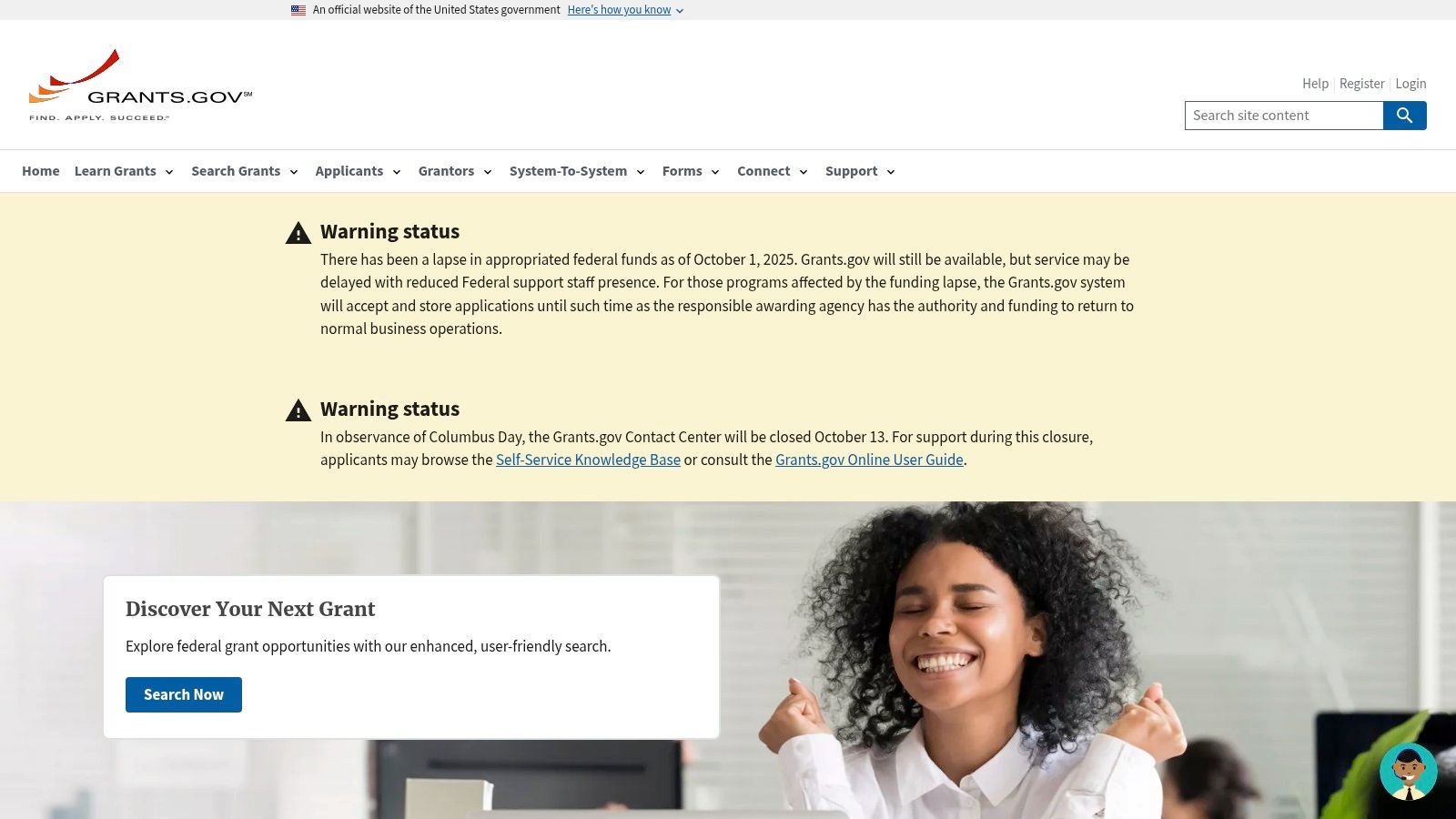
The platform is completely free to use, serving as a comprehensive database rather than a direct funder. Its strength lies in its powerful search engine and applicant workspace, which streamlines the entire application process from discovery to submission and tracking. The sheer volume of information can be overwhelming, but its extensive "Learning Center" provides invaluable tutorials and resources for first-time applicants.
Key Features and Practical Tips
The most effective way to use Grants.gov is to set up saved searches and alerts. Instead of searching for "church repair grants," use broader keywords relevant to the specific project, such as "historic building restoration," "community facility," or "disaster mitigation." This strategy will yield more relevant federal programs.
Navigating federal funding can be complex, so it's wise to review comprehensive guides on the topic. For an in-depth look at this process, you can find more information about how to navigate federal grants for nonprofits.
3. National Fund for Sacred Places
The National Fund for Sacred Places is a highly competitive grant program providing significant financial support and technical assistance specifically for congregations with historically significant buildings. It offers some of the largest grants for church repairs available, with awards reaching up to $500,000 for substantial capital projects like roof replacement, structural stabilization, and major systems upgrades.
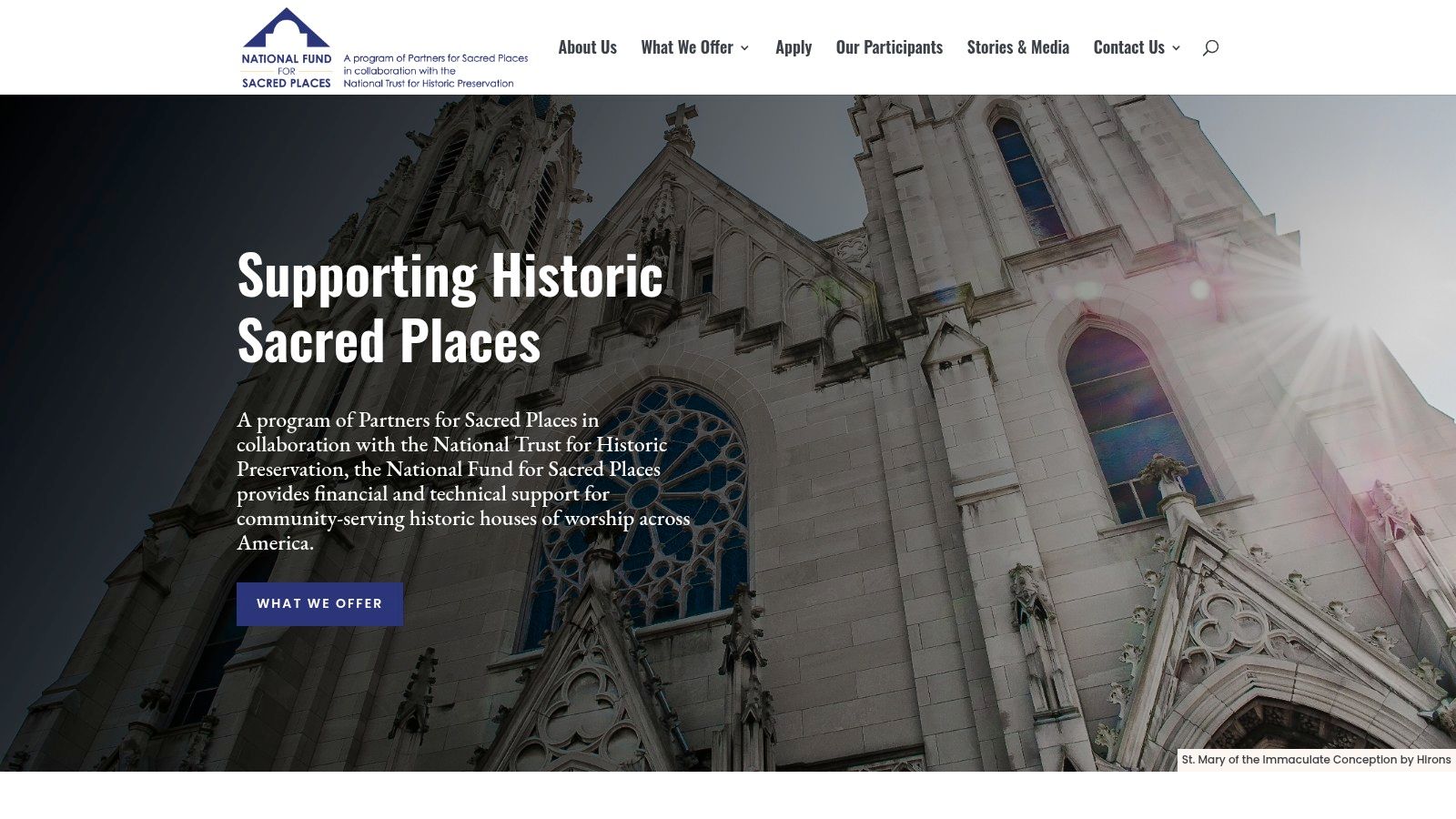
This program stands out by combining direct funding with comprehensive support. Grantees join a cohort and receive expert coaching, planning assistance, and fundraising guidance to ensure their restoration projects are successful and sustainable. The fund is a partnership between Partners for Sacred Places and the National Trust for Historic Preservation, bringing deep expertise in preservation to every project. While its national reach is broad, the application process is rigorous and highly selective.
Key Features and Practical Tips
The most critical factor for a successful application is demonstrating the building's historical and architectural significance, alongside its importance to the wider community. Applicants must have a well-developed project plan and show a strong capacity for fundraising, as the grant requires a match.
Due to its competitive nature, prospective applicants should thoroughly review the program guidelines and past awardees on the National Fund for Sacred Places website. This research helps determine if a project aligns with the fund's priorities before investing significant time in the application.
4. Partners for Sacred Places
Partners for Sacred Places is the nation’s only nonsectarian nonprofit focused on the stewardship and active community use of older religious properties. Instead of being a direct grantmaker, it acts as a crucial preparatory resource, equipping congregations with the tools and training needed to secure major grants for church repairs and manage large-scale capital projects. Their expertise is in helping congregations articulate their community value, a key element in successful grant applications.

The organization's main strength lies in its advisory services and grant-readiness programs, which guide churches through capital campaign planning, budgeting, and fundraising strategies. While some consulting services may have associated fees, the wealth of free resources, case studies, and training webinars makes it an invaluable asset for congregations, especially those new to the complex world of historic preservation funding. They co-manage the National Fund for Sacred Places, one of the premier funding opportunities in this sector.
Key Features and Practical Tips
The most effective way to engage with this resource is by using its self-assessment tools and exploring its training programs before seeking a major grant. This groundwork will significantly strengthen any future application. Focusing on their resources for building community partnerships can also unlock new, local funding avenues and demonstrate the building's civic importance to grant reviewers.
Mastering the art of storytelling and proposal development is essential, and the guidance from Partners for Sacred Places is a great start. To further hone these skills, it's beneficial to explore resources on grant writing for beginners.
5. National Trust for Historic Preservation – National Trust Preservation Funds
The National Trust for Historic Preservation offers catalytic funding through its National Trust Preservation Funds. These grants are specifically designed for the early stages of a project, making them an ideal resource for churches needing to fund planning, assessments, or emergency stabilization. While not covering full-scale construction, these awards, typically ranging from $2,500 to $15,000, provide the crucial seed money required to develop a comprehensive restoration plan.
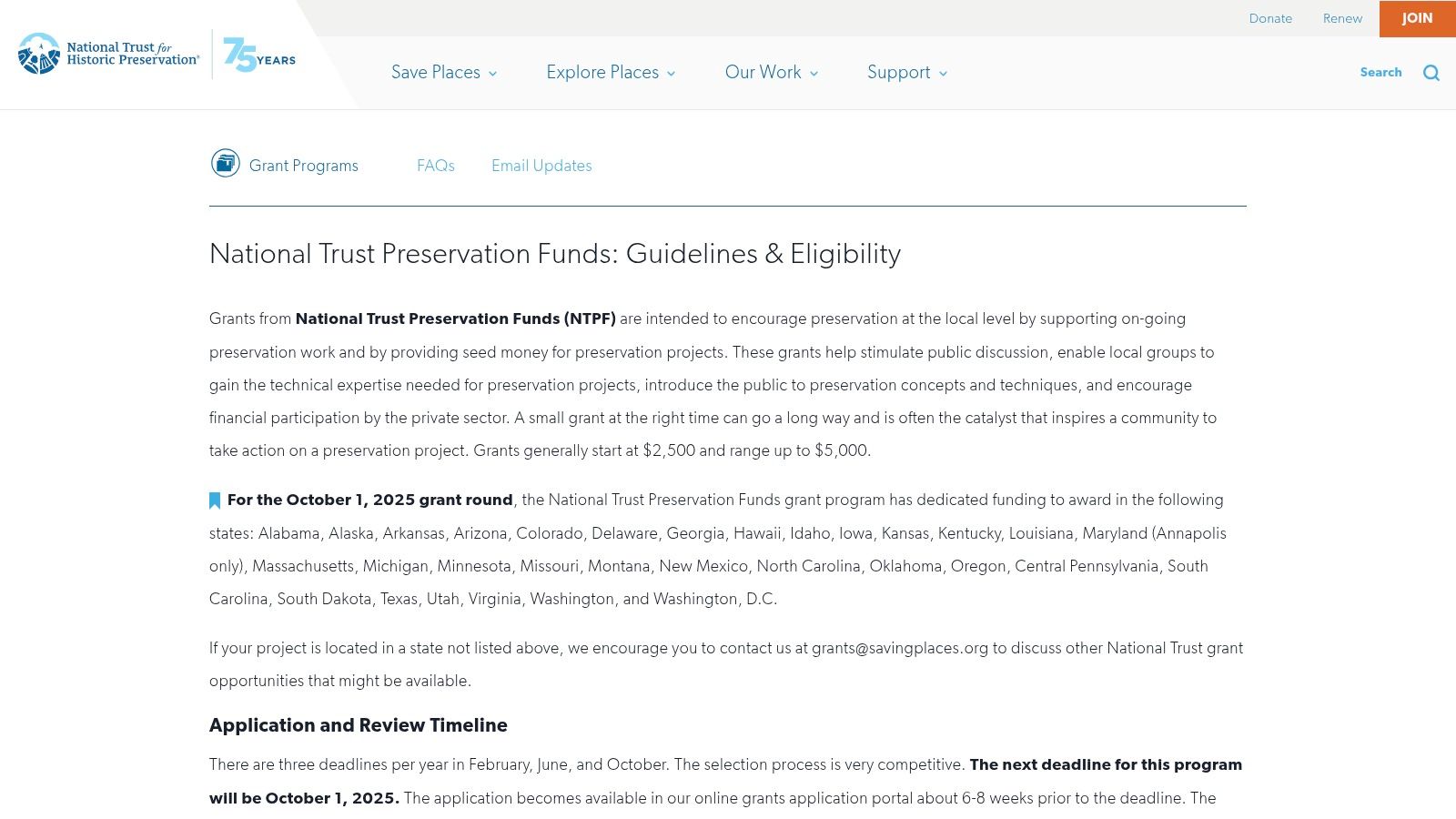
This program stands out because it funds the essential pre-development work that larger grants often won't cover. Securing a grant from such a prestigious organization can also lend significant credibility to your project, bolstering subsequent, larger fundraising campaigns. The application process is managed through their online portal and involves specific cycles for various named funds, often organized by region or theme. A key requirement is that applicants must provide a 1:1 match for the grant amount requested.
Key Features and Practical Tips
To succeed, applicants should frame their project as a critical planning or stabilization step. Focus on how a structural assessment or architectural plan will pave the way for a major restoration. The platform requires membership before funds are disbursed and a 1:1 match, so plan your budget accordingly. These smaller grants for church repairs are best used to leverage more substantial funding opportunities down the line.
For detailed eligibility and to explore the various funds available, visit the National Trust for Historic Preservation website. Reviewing past awardees can provide valuable insight into the types of projects they are most likely to fund.
6. African American Cultural Heritage Action Fund – Preserving Black Churches
The National Trust for Historic Preservation’s African American Cultural Heritage Action Fund offers one of the most significant grants for church repairs available to a specific community. This national program, with its Preserving Black Churches project, is dedicated to the stewardship and restoration of historic Black churches. It provides substantial capital grants for physical preservation and stabilization work, making it a critical resource for congregations managing landmark structures.
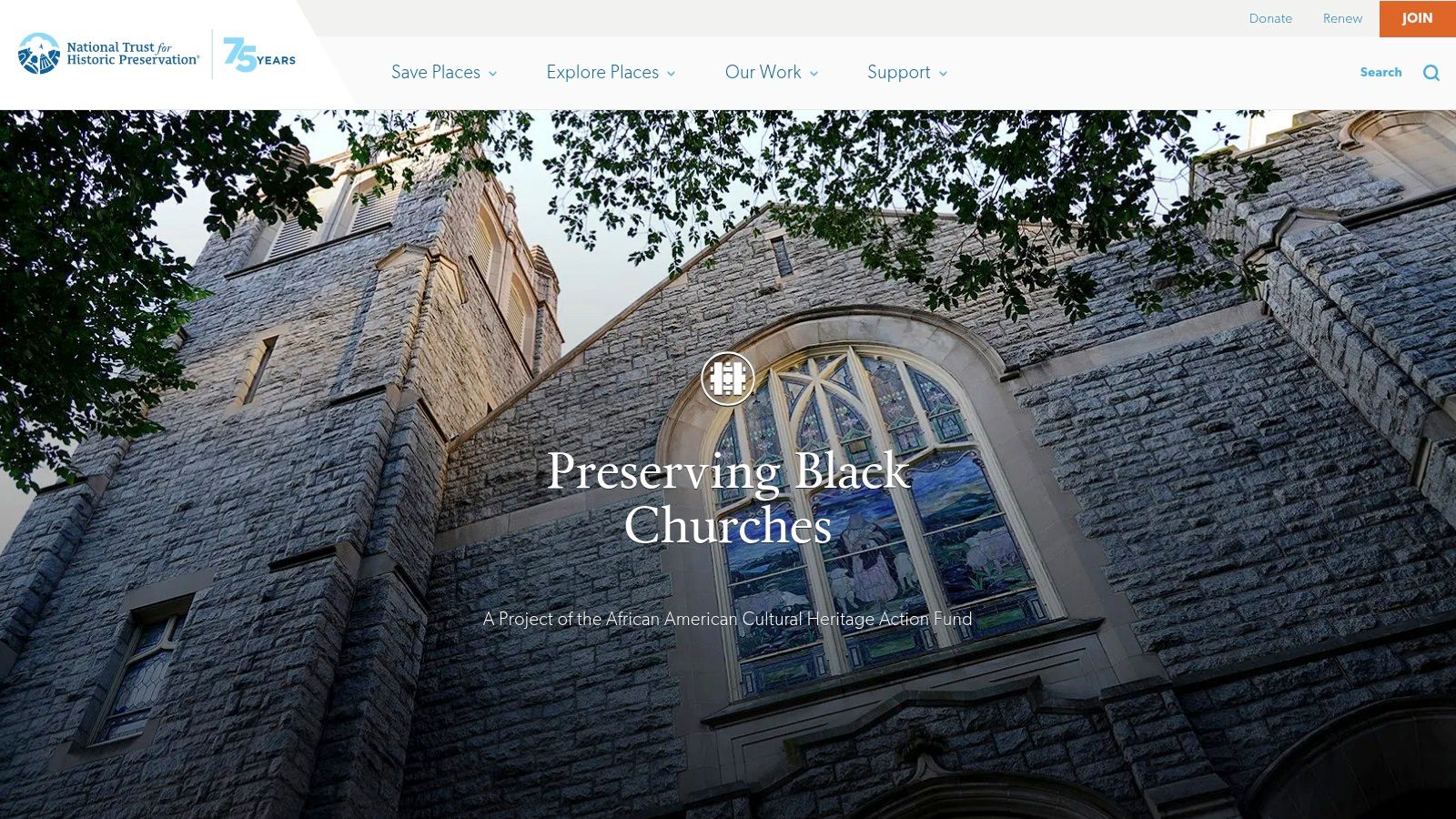
This initiative stands out due to its generous funding amounts, ranging from $50,000 to $500,000, and its holistic approach. Beyond capital projects, the fund also supports organizational capacity-building, project planning, and endowment creation. The program's website is well-organized, offering clear guidelines, application portals, and informational webinars during its annual funding cycle, which simplifies the application process for eligible organizations.
Key Features and Practical Tips
To succeed with this grant, applicants must clearly articulate their church’s historical significance and demonstrate a well-planned restoration project that adheres to the Secretary of the Interior’s Standards. The application process is highly competitive, so preparing a comprehensive narrative and detailed budget is essential. Start the application process early to gather all required historical documentation and professional assessments.
This fund is exclusively for historic Black churches and associated sites with deep cultural and community importance. You can learn more and prepare for the next grant cycle at the Action Fund’s official website.
7. FEMA Public Assistance for Houses of Worship
When natural disasters strike, FEMA's Public Assistance program can be a critical source of grants for church repairs. This federal aid is specifically designed to help communities, including private nonprofit organizations like houses of worship, recover from major disasters or emergencies. The program provides funding for the repair, replacement, or restoration of disaster-damaged facilities, making it an essential resource for congregations in federally declared disaster areas.

This program functions as a reimbursement grant, covering a percentage of eligible costs. It is not a proactive funding source but a reactive one, activated only after a presidential disaster declaration. The process is managed through state and local emergency management agencies, which guide applicants through the complex documentation and submission requirements. While the paperwork can be intensive, it is one of the few avenues for significant financial aid to restore essential community facilities post-disaster.
Key Features and Practical Tips
The most important step is to contact your local or state emergency management agency immediately after a disaster. They will provide information on applicant briefings and deadlines, which are often very short. Meticulous documentation of all damage and repair costs from day one is crucial for a successful claim. Be prepared to navigate requirements related to insurance coverage and potential loans from the Small Business Administration (SBA).
Because this funding is specific to declared disasters, it's a specialized tool rather than a general repair grant. You can learn more about eligibility and the declaration process at the official FEMA Public Assistance website.
8. Save America’s Treasures (National Park Service – Historic Preservation Fund)
Save America's Treasures is a high-profile federal grant program administered by the National Park Service. It offers substantial capital grants for the preservation of nationally significant historic properties and collections. Historic churches that are either designated as National Historic Landmarks or are listed on the National Register of Historic Places at the national level of significance are prime candidates for this prestigious funding source.
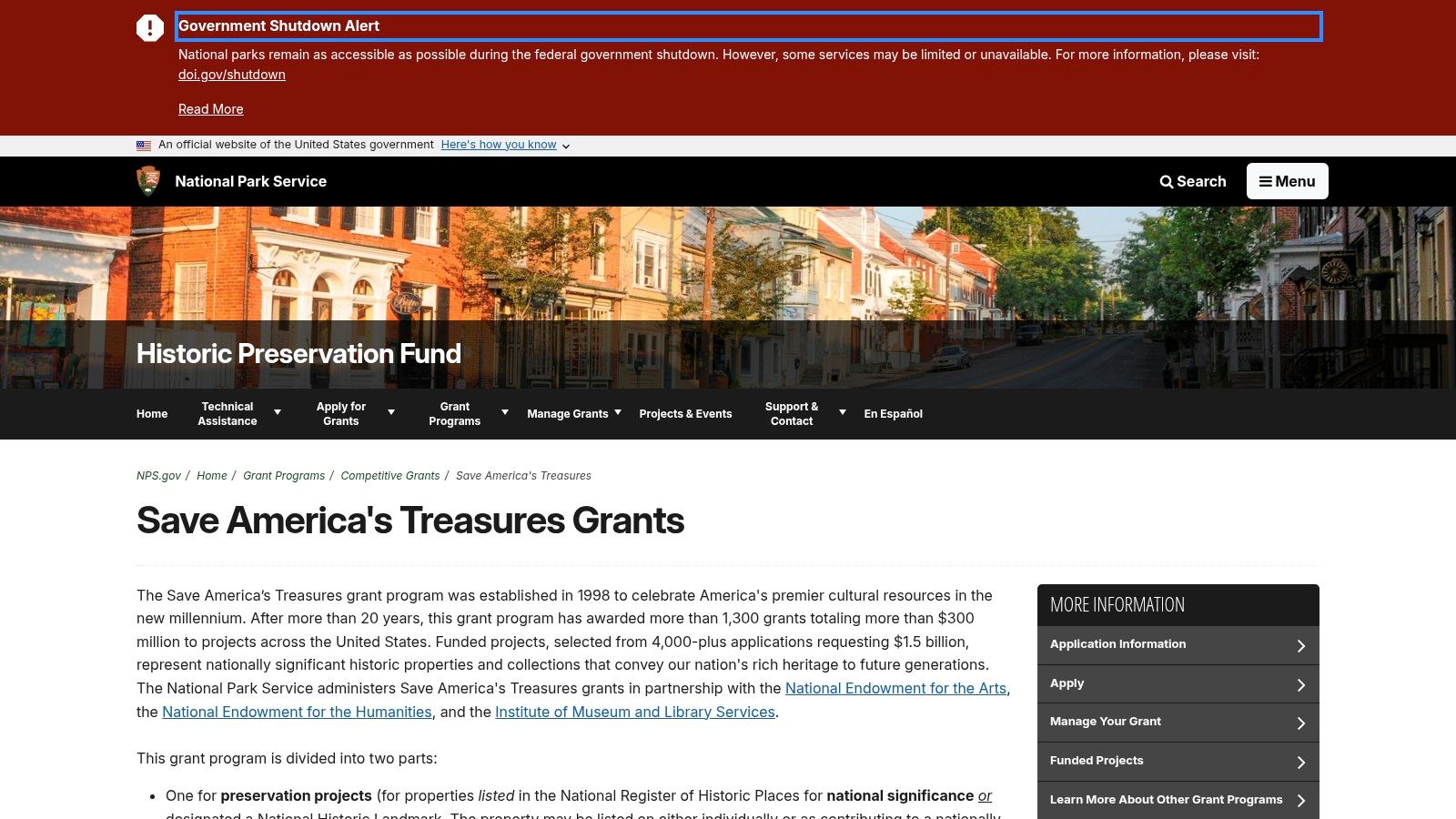
This program stands out for its focus on preserving the physical "fabric" of properties that represent America’s heritage, making it a perfect fit for major grants for church repairs involving structural integrity or historic materials. Applications are processed through Grants.gov, requiring rigorous adherence to federal preservation standards. The award not only provides funding but also validates the property's immense historical and cultural value on a national stage, which can attract further support.
Key Features and Practical Tips
The key to a successful application is demonstrating your church's undeniable national significance beyond its local community importance. This requires extensive documentation and a compelling narrative. Since applications are managed on Grants.gov under Assistance Listing 15.929, familiarity with that platform is essential. Be prepared for a highly competitive process against other nationally important landmarks.
Due to its extreme selectivity, this grant is best suited for landmark churches with a well-documented history of national importance. Explore the official program page for detailed eligibility criteria.
9. State Historic Preservation Offices (SHPOs)
State Historic Preservation Offices (SHPOs) are state-level agencies that manage federal and state historic preservation programs. For congregations with historically significant buildings, these offices are a primary source for grants for church repairs. SHPOs distribute federal Historic Preservation Fund (HPF) grants to local projects and often provide technical assistance, making them an invaluable resource for navigating preservation standards.
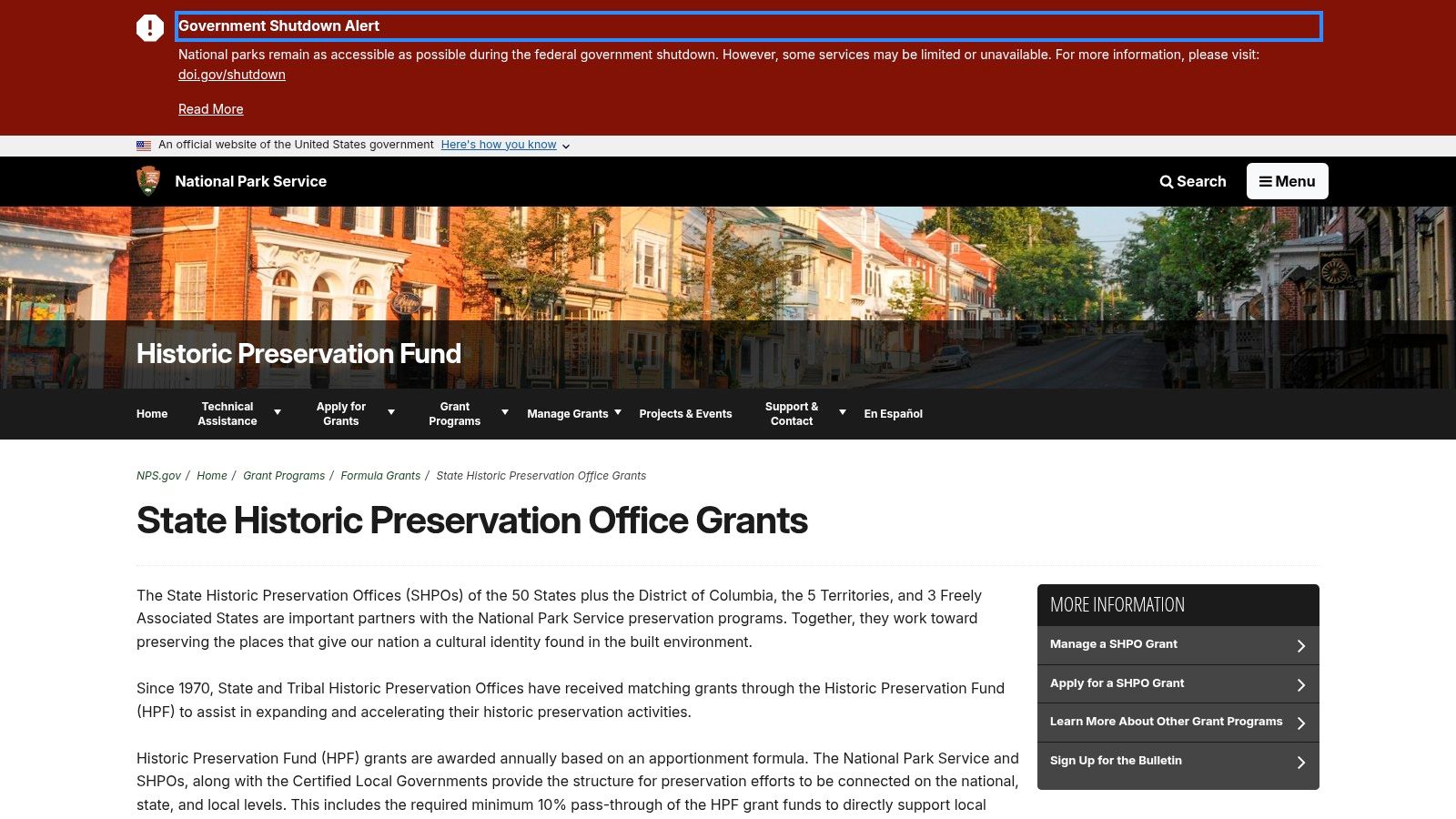
Each state's SHPO operates differently, offering a range of grants that can fund everything from initial planning and architectural assessments to direct capital repairs. Their websites are the best place to find state-specific guidelines, application deadlines, and contact information. The key benefit of working with a SHPO is the localized expertise and direct access to staff who can guide you through the application process and ensure your project meets federal preservation standards.
Key Features and Practical Tips
The most effective strategy is to build a relationship with your state's SHPO staff long before you apply. Contact them to discuss your project's eligibility and get feedback on your proposal. Funding is highly competitive and often requires matching funds, so early planning is crucial. Remember to explore if your local government is a Certified Local Government (CLG), as they often receive subgrants from the SHPO that may be accessible for smaller projects.
Because each SHPO has its own set of rules and funding cycles, it is essential to visit your specific state's website for the most accurate information. The National Park Service provides a comprehensive directory to help you find your local SHPO.
10. USDA Rural Development – Community Facilities
The U.S. Department of Agriculture (USDA) Rural Development program offers loans and grants for developing essential community facilities in rural areas. While not exclusively for religious institutions, these funds can be a critical source of grants for church repairs when the church provides essential community services, such as a food pantry, daycare, or disaster shelter. This program is designed to improve the quality of life in towns with populations under 20,000.

This government program provides funding primarily through direct loans, though limited grants are available, often in combination with loans. The key is demonstrating that the facility serves a broad public purpose beyond its religious activities. State USDA offices provide direct advising and application assistance, making the process more accessible for smaller organizations unfamiliar with federal funding procedures.
Key Features and Practical Tips
To successfully secure funding, your application must clearly separate the costs associated with the public-serving part of your facility from general worship areas. For example, if you are repairing a roof, you must demonstrate how that repair is essential for the community food bank operating in the church basement. Contacting your state’s USDA Rural Development office early in the planning process is the most effective first step.
While a powerful tool for rural communities, the funding has strict eligibility requirements. The primary focus is on the "essential community facility" function, and most awards are loans rather than outright grants. You can learn more at the USDA Rural Development website.
11. Candid – Foundation Directory
Candid's Foundation Directory is the premier database for researching private and corporate funders. While it does not directly award money, it is an indispensable tool for uncovering local and regional foundations that provide grants for church repairs and other capital campaigns. Churches can identify funders that have a history of supporting faith-based organizations or historic building preservation.
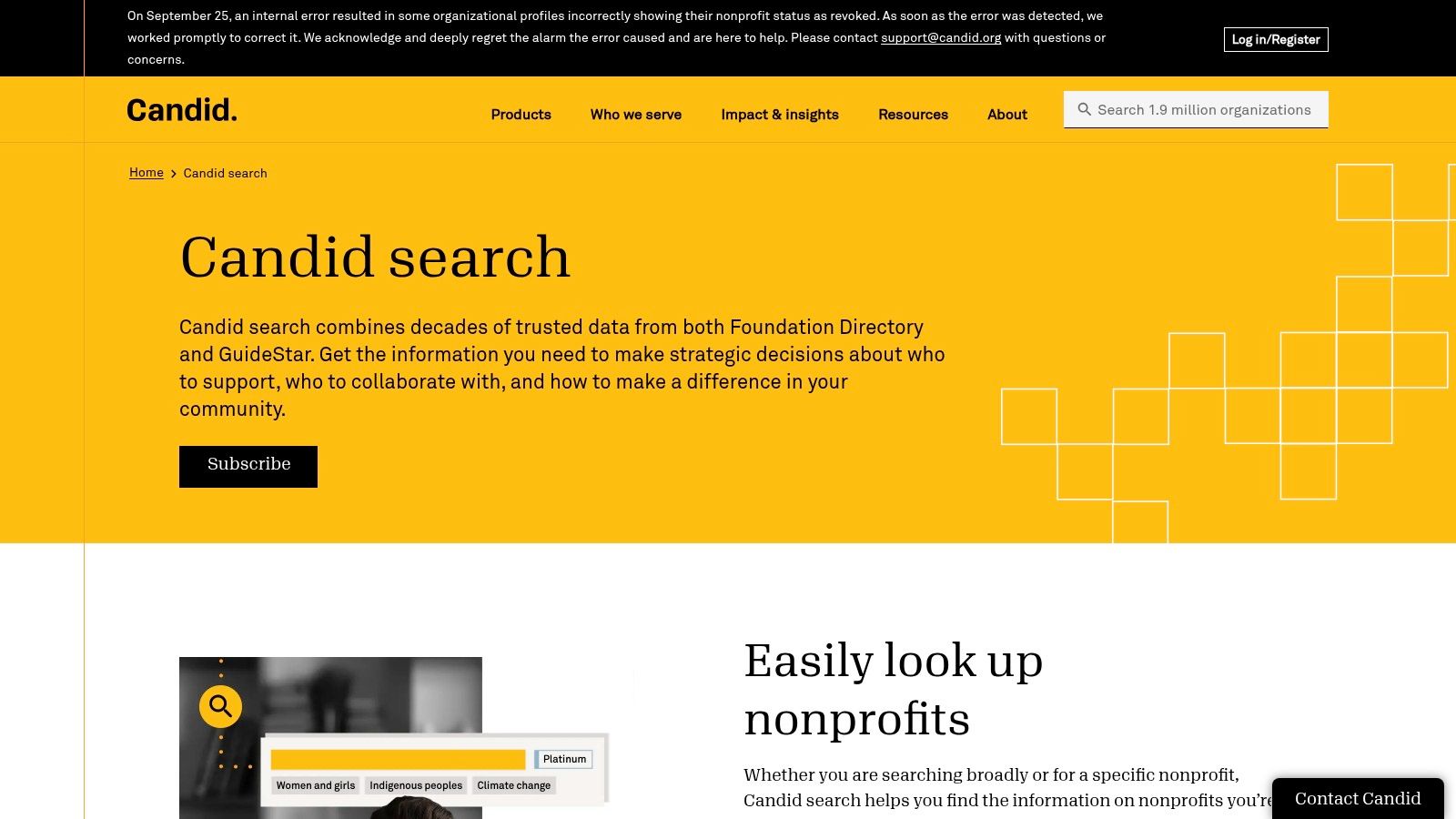
This platform is a subscription-based service, but its value lies in its unparalleled depth, with profiles on over 300,000 grantmakers and 29 million grant records. The detailed data allows you to see who funds projects like yours, how much they give, and who they have funded in the past. While there is a learning curve, Candid offers extensive training resources to help users maximize its powerful features.
Key Features and Practical Tips
To use the Foundation Directory effectively, filter searches by geographic location and "capital and infrastructure" as the support type. Look for foundations that have previously funded other religious organizations. This information helps you tailor your proposal and benchmark an appropriate funding request based on the funder's typical grant size for similar projects.
While Candid requires a paid subscription, many public libraries and community foundations offer free on-site access through their Funding Information Network. You can find a location near you to utilize this powerful grant-seeking tool.
12. Catholic Extension
Catholic Extension is a national fundraising organization dedicated to supporting and strengthening under-resourced Catholic dioceses across the United States. It provides critical grants for church repairs, construction, and renovations, focusing exclusively on parishes within designated "Extension Dioceses" that lack sufficient local funding. The organization offers various grant types, including matching grants that encourage and amplify local fundraising efforts for facility improvements.

This platform stands out due to its singular focus on building the Catholic Church in America’s poorest regions. Its grant programs are well-structured, covering everything from minor repairs under $5,000 to major matching grants that can reach up to $100,000. However, access is strictly limited to pre-approved dioceses, and the application process requires significant diocesan oversight, architectural vetting, and compliance with specific technical standards.
Key Features and Practical Tips
To determine eligibility, parishes must first confirm if they are located within an active Extension Diocese by contacting their diocesan leaders. Applications are not submitted directly by parishes but are coordinated through the diocesan bishop’s office. This ensures all projects align with broader diocesan needs and meet the funder's rigorous requirements for planning and financial accountability.
This funder is an ideal partner for eligible Catholic parishes needing significant capital for repairs, but it is not a resource for other denominations or for parishes outside its designated mission territories. You can find more details about their specific programs at Catholic Extension's Church Construction & Repairs page.
12-Source Grants Comparison Matrix
Turning Your Plan into a Winning Proposal
Navigating the landscape of grants for church repairs can feel overwhelming, but as this guide has shown, a wealth of opportunities exists for congregations willing to invest the time in strategic planning and thoughtful application. From the broad federal databases like Grants.gov and specialized national programs like the National Fund for Sacred Places, to state-level SHPO grants and hyper-focused initiatives like the African American Cultural Heritage Action Fund, the key is to identify the funders whose missions align perfectly with your project's goals.
Remember, securing funding is about more than just needing a new roof or restoring a historic steeple. It’s about articulating your church’s irreplaceable role in the community. Whether you're a vital hub for social services, a landmark of architectural significance, or a cornerstone of local history, your narrative is your most powerful tool. The most successful grant applications weave a compelling story supported by concrete evidence, including professional assessments, detailed budgets, and letters of community support.
From Research to Action: Your Next Steps
The journey from identifying a potential grant to submitting a polished proposal requires organization and a clear strategy. To move forward effectively, consider these actionable steps:
- Prioritize Your List: Review the resources we've covered. Start by shortlisting the 3-5 grants that most closely match your church’s specific repair needs, historical status, and community impact. Don't waste time on long-shot applications; focus your energy where you have the highest chance of success.
- Assemble Your Grant "Kit": Begin gathering essential documents now, even before you start writing. This includes obtaining high-resolution photos of the needed repairs, securing formal cost estimates from qualified contractors, gathering letters of support from community leaders, and compiling a concise history of your church and its service.
- Develop a Master Narrative: Create a core document that clearly outlines your project. This "master proposal" should detail the problem (the required repairs), the solution (your plan and budget), and the impact (why this project matters for your congregation and the wider community). You can then adapt this core narrative for each specific grant application, tailoring it to the funder's priorities.
Choosing the Right Path for Your Church
The resources in this article cater to different needs. If your church is a designated historic landmark, programs from the National Trust for Historic Preservation or Save America’s Treasures are your ideal starting points. For rural congregations, the USDA’s Community Facilities program might offer a unique pathway. For those affected by natural disasters, understanding the FEMA Public Assistance program is non-negotiable.
Ultimately, the most critical factor is preparation. A well-researched, passionately written, and meticulously detailed proposal stands out. By leveraging the right information and presenting your case with clarity and conviction, you transform the daunting task of securing grants for church repairs into a manageable and achievable goal, ensuring your sacred space can continue its vital mission for many years to come.
Ready to streamline your search and accelerate your funding success? Fundsprout uses AI to match your specific church repair project with the perfect grant opportunities, helping you build a powerful proposal that gets noticed. Stop searching and start funding by exploring your options at Fundsprout today.
Try 14 days free
Get started with Fundsprout so you can focus on what really matters.
